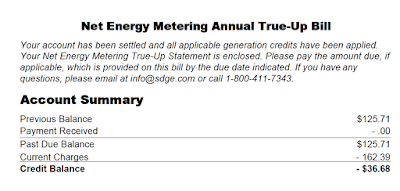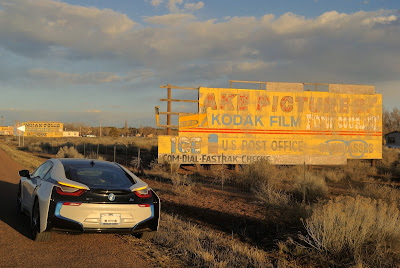Our yearlong journey, "Driving to Net Zero Energy" has now come to an end. Thank you to BMWi, ChargePoint, Inside EV's, Stellar Solar, the Center for Sustainable Energy (CSE) and SDG&E, for following us and supporting us during this past year.
Our two BMW i3’s and our home were powered by harvested sunshine from a small portion of our roof with zero gasoline cost and zero utility cost for the last year…for forever. We did it!
We believe we are the first household in the world to do this with full documentation. We also believe that there are dozens, perhaps hundreds of other households who have accomplished the exact same thing without going though the painstaking detail and very public process of sharing private and personal information.
 |
| My hero is an imaginative and creative child. |
Our two BMW i3’s and our home were powered by harvested sunshine from a small portion of our roof with zero gasoline cost and zero utility cost for the last year…for forever. We did it!
We believe we are the first household in the world to do this with full documentation. We also believe that there are dozens, perhaps hundreds of other households who have accomplished the exact same thing without going though the painstaking detail and very public process of sharing private and personal information.
Why this scope & scale?
There’s something traditional, in an American sense, about a home and two cars in the garage. We are a nation that came of age the past 100 years concurrent with the era of the automobile. For better or worse, our homes and cars are together entwined with the embodied energy of our built history. For better, we can now power both our homes and our cars with renewable energy, in our case with sunshine. We can also effect change on this personal level of our own lives, it’s harder to do on a citywide or national scale.
“The inertia of the status quo, is a powerful foe of
progress”
There is safety and security in the status quo but there is no future, only a past.
There is safety and security in the status quo but there is no future, only a past.
It is for this reason that we decided to do the Driving to Net Zero Energy challenge, why I write, why I share as broadly as possible our personal and private information, why I serve as a Planning Commissioner of the nations 5th largest county by population, so that I, that we collectively, can help “break the broken” status quo, and move ourselves, our families and our cities to a far better, richer, healthier future.
The gas station down the street, the power-plant in the
next city over, and the oil wells across vast seas and deserts, have served our
households and transportation energy needs during the past 100 years. They are
now giving way to the homeowner who fuels their own home and cars with electricity from solar harvested from the roof of their home. An ecosystem of a dwelling, an energy plant
and transportation all contained in one unit, enriching the owners whether a home, a commercial hub
or a city.
As a society, we have arrived at a destination,
an intersection of our historic calendar and our always-advancing technology
prowess whereby today, our cities, our homes and our electric transportation choices can be
powered by renewable energy generated by a homeowner. During the
next 20 years, our country and our individual households will see changes in
energy and transportation that are hard to comprehend in their magnitude and
benefits to our environment, safety and health, and to our household budgets.
Our year in review:
Let’s start with a couple of 800 lb. gorillas and get them out of the way.
Let’s start with a couple of 800 lb. gorillas and get them out of the way.
1.
Although we have no cost of energy or gasoline
for our home and two cars, saving us about $8000 a year, we are not 100% energy
independent. We are grid connected; we
have had a very slight amount of electricity use for the year and a small amount of
natural gas use. There is no economic
reason to go any farther than below zero cost,
but half our goal is to be energy neutral, this has still not been
reached. Our cost are zero and our usage
is de minimis. You’ll see this in the
charts below.
2.
If you
think you can plan a year in the future, think again. Our year has unfolded
with several unexpected events not foreseen during our planning for the year.
We made a last second decision to host a
Rotary International French exchange student for a year so that two young
students, one from France staying with us, and one from Coronado going to France could have the
experience of living a year abroad. Another person in the household with a full head of hair and an energy
hog hair dryer added to our annual total. I actually calculated her monthly
(85kwh) energy consumption, I know, that's a little obsessive, compulsive.
We expected to drive 20,000 miles this
year; we ended up driving 21,477 miles.
We lost a family member, priorities about
energy savings we’re inconsequential during these months of care giving and
grieving.
After three years of being a two EV
household, after working with and Field Test driving for BMW during the past 5
years beginning with the BMW Mini-E, I had the opportunity to buy a very special one
off Electronaut Edition of the BMW i8.
During the last 2 months of the 12 month "Driving to Net Zero" challenge, we were a three car household. The BMW i8 took a couple of long road trips
and it’s a very special collectible car that will see a road trip or two a year
and a scant couple of hundred miles a month.
Our two i3’s remain our daily drivers. Our challenge was 20,000 miles a
year in the two i3’s which we surpassed. The BMW i8 (a plug in gasoline hybrid) is a dream and a collectible and
we are fortunate to own such a car.
Even as a two EV family before the BMW i8, once or twice a year we would borrow a gasoline car for a long driving trip. We take the occasional plane flight, cruise ship, train, bus and taxi, all of which consume gasoline, avgas or diesel. So we possess no "EV purity card" and never have, as the rest of the transportation network is not quite as advanced as our household.
Even as a two EV family before the BMW i8, once or twice a year we would borrow a gasoline car for a long driving trip. We take the occasional plane flight, cruise ship, train, bus and taxi, all of which consume gasoline, avgas or diesel. So we possess no "EV purity card" and never have, as the rest of the transportation network is not quite as advanced as our household.
We realize how fortunate we are in life, and
that we are not the statistical norm. However in California at least, Solar PV
is making its way to all income levels and housing types and EV’s can be leased or purchased for well under $200 a month. Living Net
Zero does not need to be done in a custom home with BMW’s in the garage.
Lastly, we think that’s what makes this "Driving to Net Zero" challenge so special. It’s a real home with real people, real lives that are wonderfully
unpredictably complicated, covered over the course of a year. It’s not an unoccupied home on a University
campus built by a car maker. It’s not a theoretical calculation of energy use by
a home builder or a University. It’s
real, it’s us, "warts and all" for a year.
Now our year of data in review :)  |
| Julie is a more efficient driver, and a credit for the year of -$751 |
Our annual gasoline cost for two cars, 21,477 miles, $0.00
Our annual natural gas cost, $279.89
Our annual total cost of energy $-471.36
Our energy challenge began on May 15th, 2014, when we received both BMW i3's, the most efficient car in the USA. Our annual true up bill from our utility begins every year on January 15th. As you can see we are on a great trajectory for 2015 and we expect this to continue resulting in an overproduction of around 1200 kwh of electricity. The stronger sunshine summer months are approaching.
 |
| A monthly view of the same data. |
A total of 5061 kWh of electricity was used to drive 21,477 miles in two BMW i3’s.
Our 8.5kw Solar PV system generated 13,546 kWh for the year. This equals 1593 kWh per kw system size.
A 3.18 kw Solar PV system (3.18 times 1593) would provide the 5061 kwh of power for both BMW i3s driven 21,477 miles.
Julie averages 4.3 miles per kwh 11,862 miles / 2717kWh
Peder averages 4.1 miles per kwh 9615 miles / 2344 kWh
Peder averages 4.1 miles per kwh 9615 miles / 2344 kWh
 |
| We both have our own port and swipe our separate ChargePoint cards to activate the individual ports. This is how we tabulate each car and driver separately. |
 |
| Love the BMW i3's, that they plug into the sunshine on our roof. |
 |
| When you live in a home and drive EV's powered by solar, every aspect of emissions is reduced, thus improving the air quality for all. |
 |
| Before our solar and electric cars, we had fun powerful but gas guzzling cars and a high cost of gasoline and utilities. |
 |
| Today, this picture and graph represent our cost. The $245 was an estimated cost for nat gas when this slide was made several months ago. |
 |
| This was calculated when gas in our region was $3.50 a gallon. Today's gas prices are $3.93 a gallon. Now you see how I can afford to drive the BMW i8 :) |
Our 8.5kw Solar PV system generated 13,546 kWh for the year. This equals 1593 kWh per kw system size.
A 3.18 kw Solar PV system (3.18 times 1593) would provide the 5061 kwh of power for both BMW i3s driven 21,477 miles.
The total cost of the 3.18 kw PV System is equal to buying gasoline for 2.82 years. An ROI of 35.4%
Driving the BMW i3’s powered by Solar PV, the cost per mile is $0.017 cents per mile.
If advantageous TOU rates are factored in as our case, the Solar PV system size and cost would be reduced by 22%, the cost is $0.013 per mile.
Driving on Solar PV supplied electricity is 1/10th the cost of driving on gasoline.
Thank you to you the reader for following us on this year long journey. Thank you for your many comments and questions throughout the year. One of the unexpected joys, and I am so fulfilled when I hear it, is the dozens of times in the past year folks have thanked me for writing and for inspiring them and giving them confidence to do similar, to what we have done.
Just take a small step, a small reduction in energy use or a slightly more efficient car or transportation choice if you can. You don't need to go all "Full Monty" to a make a meaningful contribution to improving your city and your budget for your family.
It has been an iterative process for us the last several years beginning with solar in 2007 and with two gasoline cars and a toe in the water with the BMW Mini-E in 2009 to where we are today.
Get started and change your world, you can live and drive on Sunshine.
For more information about our systems and cars read the first post, Energy Challenge Introductory Article of this series below.
Cheers
Peder
(Past "Driving To Net Zero" articles)
(Past "Driving To Net Zero" articles)



















.jpg)
.jpeg)